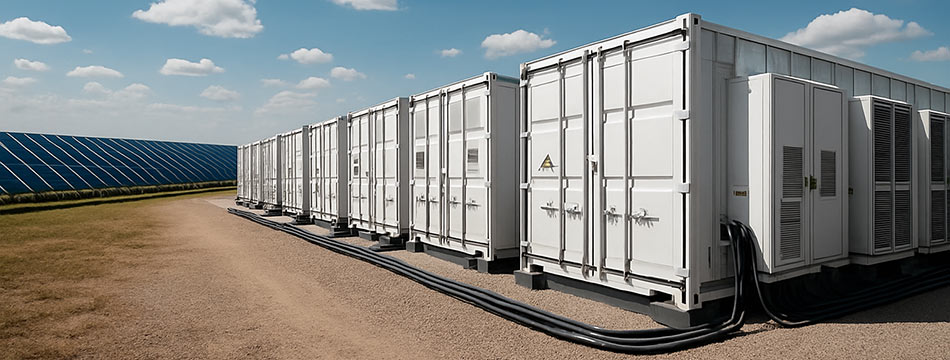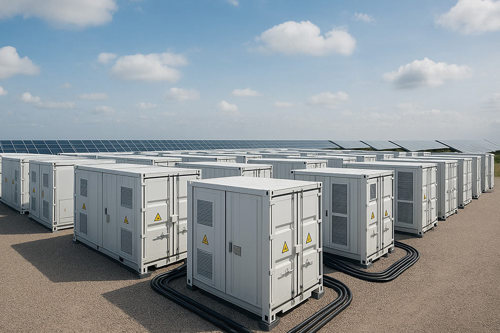
Turning renewable energy into reliable power with BESS
As the world transitions to cleaner and more resilient energy systems, renewable infrastructure continues to expand rapidly. Wind, solar and other renewable sources play a central role in reducing dependence on fossil fuels, but their output is inherently variable and intermittent. When the wind is not blowing or sunlight levels are low, renewables cannot consistently deliver power to the grid.
The solution is to store excess energy produced during peak renewable generation, for example sunny afternoons, and release it when production is low, for example at night or on calm days. This is where Battery Energy Storage Systems (BESS) become essential.
What is a BESS?
A BESS captures energy from renewable sources such as wind and solar, and/or from the electricity network, and stores it using rechargeable battery technology. The stored energy can then be released during periods of high demand.
Typically, lithium-ion technology is used for BESS. However, storage technology at utility scale is considerably more advanced than batteries found in other applications such as electric vehicles.
Large utility scale systems, often referred to as Front of Meter (FoM), allow grid operators to:
- Manage energy release during peak demand or outages.
- Provide grid services such as balancing, frequency and voltage control.
- Optimize renewable energy use and ensure stable electricity supply.

Main components of a BESS
A BESS consists of batteries connected in series or parallel to achieve the required operational voltage and capacity. The subsystems ensure safe and efficient operation:
- Battery Management System (BMS): Monitors and optimizes battery performance, cell balancing and safety.
- Inverters / Power Conversion System (PCS): Converts DC battery voltage to AC for grid integration and vice versa.
- Thermal Management Systems: Maintain safe and consistent operating temperatures at cell and module level.
- Energy Management System (EMS): Manages charging cycles, grid flow and energy arbitrage.
BESS Control System Requirements
Utility scale BESS sites with large power capacities increasingly rely on proven industrial process control and safety technologies integrated into wider IoT systems. This provides more reliable control and improved data availability compared with microcontroller based solutions typically used in smaller BESS.
At grid level, Battery Energy Storage Systems require a robust Control and Instrumentation (C&I) infrastructure to ensure safe, reliable and efficient operation.
Signal conditioning for safe and reliable BESS operation
PR electronics has been trusted by customers in the renewable and wider energy sector for many years. Our signal conditioning products are proven to ensure superior signal integrity and safety in BESS and other energy applications.
Our devices support key BESS functions including:
- State of Charge (SOC) monitoring.
- State of Health (SoH) monitoring.
- Cell balancing.
- Thermal management.
- Power Conversion System (PCS) control and monitoring.
- EMS and SCADA integration.
The sections below describe each function in detail.
State of Charge (SOC) monitoring
Accurately determining the state of charge is critical for both maintaining battery health and knowing exact export capacity.
- PR 4184: With a response time of less than 20 ms and input support up to 300 VDC or 100 mA, it is an ideal solution for interfacing battery SOC values.
State of Health (SoH) monitoring
The state of health of a battery is an important factor in determining replacement strategies. Understanding performance and degradation over time is complex and involves techniques such as capacity and resistance testing.
- PR 4114: With universal input options, it is suited to interfacing with the various signals required to assess SoH.
Cell balancing
To maximize battery performance and realize full potential, individual cells must be balanced at the same level of charge. If one cell is at a lower SOC, it will deplete before the other cells and stop energy transfer while charge remains in the others. The same applies when charging.
- Passive balancing dissipates excess energy from high voltage cells as heat via resistors.
- Active balancing transfers energy from high voltage cells to low voltage cells.
Both methods rely on electronics and algorithms to achieve consistent balancing.
- PR 4184 and PR 4104: Provide fast response for voltage and current measurement during balancing.
- PR 5437: Dual input temperature transmitter for measuring cell temperature differentials to maintain safety.
Thermal management
Strict temperature monitoring at cell and module level is a critical safety measure. Stable temperature control of operating and ambient conditions ensures both efficient battery operation and functional safety to mitigate the risk of thermal runaway or fire.
PR electronics offers solutions for both standard and SIL rated applications:
- PR 5437 SIL certified head mount transmitter and PR 6437 DIN rail transmitter.
- PR 4116 trip amplifier with temperature input.
- PR 9116 SIL2 certified trip amplifier with relay output for overtemperature alarms.
Power Conversion System (PCS) controller
The PCS manages the inverters and converters that link DC batteries to the AC grid and vice versa.
- PR 4179: Universal AC/DC transmitter that interfaces with AC voltage or current signals for monitoring inverters and relevant PCS signals.
EMS and SCADA integration
Integration with higher level energy management systems and SCADA is essential for reliable BESS operation.
- PR electronics signal conditioning devices support analog and digital signal interfacing, including MODBUS communication, making them ideal for EMS and SCADA connectivity.
Additional applications
PR electronics devices can also be used for:
- Environmental Monitoring such as temperature, humidity and gas detection.
- Fire Detection and Suppression through alarm and interlock integration.
- Protection and Safety Systems with IEC61508 certified interfaces for safety instrumented systems up to SIL3.
Conclusion
Battery Energy Storage Systems are essential to turning renewable energy into reliable and continuous power. With proven signal conditioning technology, PR electronics helps ensure the safe, efficient and stable operation of BESS worldwide.

